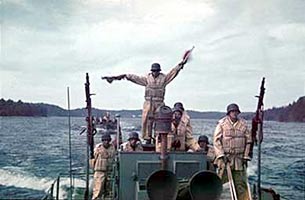War on Lake Ladoga 1941 – 1944According to the conditions of The October 14-th 1920 Tartu Peace Treaty between Soviet Russia and Finland the sides must not have on Lake Ladoga military vessels of more than 100 metric tons displacement; guns of caliber greater than 47 mm; military bases and installations. After Soviet Union aggression on November 30-th 1939 The Tartu Peace Treaty lost its force but during the winter 1939-40 the military actions on the lake were practically absent as the lake was frozen. After the Winter War according to The March 12-th 1940 Moscow Peace Treaty, Lake Ladoga became a USSR internal basin. On June 25-th 1941 487 Soviet bombers took a massive action against Finnish territory. Finland was again at war with USSR. Just after the Finnish army reached the shores of Lake Ladoga, the rebuilding of the Ladoga Navy started. A command post was established on August 2-nd in Läskelä and by August 6-th nearly 150 boats, 2 tugboats and 4 ferryboats were transferred to Lake Ladoga. The vessels were armed with 47 mm guns and machineguns. Tugboats were re-equipped into minelayers. Coastal batteries equipped with long-range 100-mm and 88-mm guns were also established. After taking Lahdenpohja (10-th of August) and Sortavala (15-th of August) headquarters of Ladoga Flotilla were moved to Sortavala and Lahdenpohja become the main operations base. Later on, according to land forces movement, auxiliary bases were established in Sortanlahti, Käkisalmi (Kexholm) and Salmi. On the morning of September 7-th 1941 after 10-minutes artillery preparation and under the cover fire of coastal batteries the boats and launches of Ladoga Flotilla started landing on Rahmansaari Island that was still held by Soviets. By midday Soviet troops were broken up and surrounded in several strongholds. Despise the reinforcement brought by Soviet Ladoga Flotilla from nearby Heinäsenmaa and Verkkosaari Isles and from the Vaalam Island and it's later attempts to deliver ammunition to the surrounded and evacuate the remnants of Soviet garrison by the evening of September 10-th the resistance was finally suppressed. The killed Soviet soldiers were buried in a common grave marked with a wooden cross with inscription in Finnish: "Here lay 110 Red Army soldiers fallen in battle on 7-9 September 1941 on Rahmansaari Island". On June 22-nd 1942 the Italian 12-th Torpedo Boats Detachment consisting of vessels MAS 526, MAS 527, MAS 528 and MAS 529 (displacement 20 metric tons, 2000 HP engines, 2 torpedo launchers, 20-mm machine-gun, 6 depth-charge bombs, smoke generator) built in 1939. Based on this detachment the KM Boats Flotilla was formed. It included also 6 German minelayers. During the summer of 1942 Axis navy forces on Ladoga were reinforced by transferred German Siebel Attacking Landing Crafts (self-propelled 144 metric tons displacement armed ferries) that were initially meant for The Channel crossing. These ferries were catamarans built over two pontoons united with a wide bridge with armored structures. The heavy-armed vessels were equipped with three 87-mm guns and two 20-mm multi-barrel anti-aircraft machine-guns. The light-armed ones were equipped with one 37-mm gun and two 20-mm multi-barrel anti-aircraft machine-guns. Two petrol engines with silent underwater exhaust could give them speeds of up to 10 knots. The vessels draught does not exceeded 1 meter. By the 15-th of July 1942, 15 of the first ALB vessels were transferred by ferry from Tallinn to Helsinki and hence by railway to Lahdenpohja. Later on their number were increased to 30. They were united to a special flotilla with 2400 personnel under the command of ALB inventor German Lieutenant-Colonel Fritz Siebel. Both Axis Ladoga-based flotillas were formally placed under the command of Finnish Ladoga Coastal Defense Brigade and were based in Lahdenpohja but acted under the commands of German Navy High Command. On the South of Lake Ladoga some 20 miles from New Ladoga, that was still held by the Red Army, there is a small artificial isle of Suho, were a stone-built lighthouse was erected in 1891. The isle occupied a tactically important position and allowed controlling a large region in southern part of the lake. The garrison of the isle consisted of 90 people and was equipped with the 3-unit 100-mm gun battery and several machinegun pillboxes. German Navy Command worked out the "Basil" plan to take the Suho isle. In the night to October 9-th 1942, Siebel LBA flotilla supported by 4 Italian torpedo boats, with 100-men special forces detachment onboard, set out aiming at Suho Isle but being lost in fog returned by the morning to the auxiliary base in Sortanlahti. The next attempt was made in the night to October 22-nd 1942. Using cover of bad weather the vessels came close to the isle unnoticed and destroyed the radio station from the first salvo. But a Soviet patrol-boat happened to be on patrol in that region and had noticed the landing forces, informed Soviet Command and attacked the enemy vessels. As a result several vessels were damaged and after an air attack by 4 bombers, only 70 commandos managed to land on the isle at 8 o'clock AM. They failed to capture the artillery battery and after a short hand-to-hand combat were driven to the Western part of the isle from where they were evacuated. At 9 AM. Soviet planes attacked the landing vessels retreating to Northwest. Later on the landing flotilla was overtaken and attacked by Soviet patrol-boats. Out of 23 vessels that took part in the landing operation 17 were sunk or seriously damaged. In November 1942 Italian torpedo boats were transferred to the Baltic See via Saimaa Canal. After that, there were no serious naval operations on Lake Ladoga. According to The September 19-th 1944 Moscow Peace Treaty, Lake Ladoga again become a USSR internal basin.
Based on the materials published at Soviet open sources
Visit Antti Joronen's War Photo Gallery – memoirs of a participant in military actions on Ladoga in August-September 1941 (with lots of photos). |
